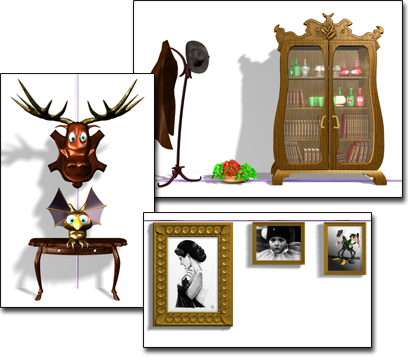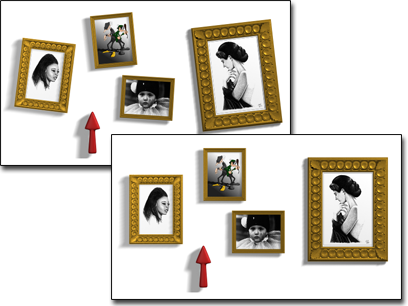You can align a selection consisting of one or more objects, called the source, with a target object. There are many uses for this feature. For precision, an important use is grid alignment. You can create a new grid object and align it to an existing object, either manually after creation or automatically during creation using the AutoGrid feature. Conversely, you can move an object onto a grid anywhere in your scene.

Aligning objects by the centers, bottoms, or tops of their bounding boxes
Source and Target Objects
Alignment involves two entities: one is the source object or selection set, where the process begins; the other is the target object, where the selection process ends.
- Source object
-
Object or objects you want to move into alignment with another object. You select one or more source objects to begin the alignment process.
- Target object
-
Object used to define the alignment. You select the target object during the alignment process. It cannot be selected beforehand.
After selecting the source, choose Tools menu
 Align or click the Align button on the Main toolbar, and then select the target object.
Align or click the Align button on the Main toolbar, and then select the target object. Next, the Align dialog appears. For discussion of the Align options, see Align.
Setting a Coordinate System
The effects of alignment depend on the current reference coordinate system, such as View, World, or Local. You should decide which system you want to use before beginning alignment.
- Reference Coordinate System
-
Determines the axes used for positional alignment and the size of the bounding box for maximum and minimum positions.
To align objects using active grid axes:
- Choose Grid as the reference coordinate system from the list on the toolbar.
To align two objects using their own axes:
- Choose Local as the reference coordinate system. Alignment is then strictly between the two objects. Object bounding boxes determine maximum and minimum positions.
As a reminder to you during the alignment process, the current reference coordinate system appears in parentheses following the Align Position label in the Align Selection dialog.
Basics of Aligning Objects
Alignment controls are on a single dialog. As you make a setting, the object being aligned moves immediately to the new position. This lets you experiment with alignment until you get what you want. Settings can be made in any order.
You can also work step-by-step, by applying position choices, for example, before deciding on final orientation. You can cancel at any time, returning the scene to its original state. You can also undo any alignment and start over.
Aligning Multiple Objects

Aligning multiple objects to the arrow object (each photo is adjusted in a different correction)
When you select multiple objects for alignment, the same settings apply to all of them. However, the effect on each source object can be different. In practice, you're aligning separate objects at the same time with the same settings.
To align a collection of objects as a single unit, select the objects and group them. The alignment now takes place relative to the pivot and bounding box of the entire group.
Sub-Object Alignment
You can use Align with any selection that can be transformed. The tripod axis becomes the source for alignment. You do this by accessing the sub-object level of the object before clicking Align.